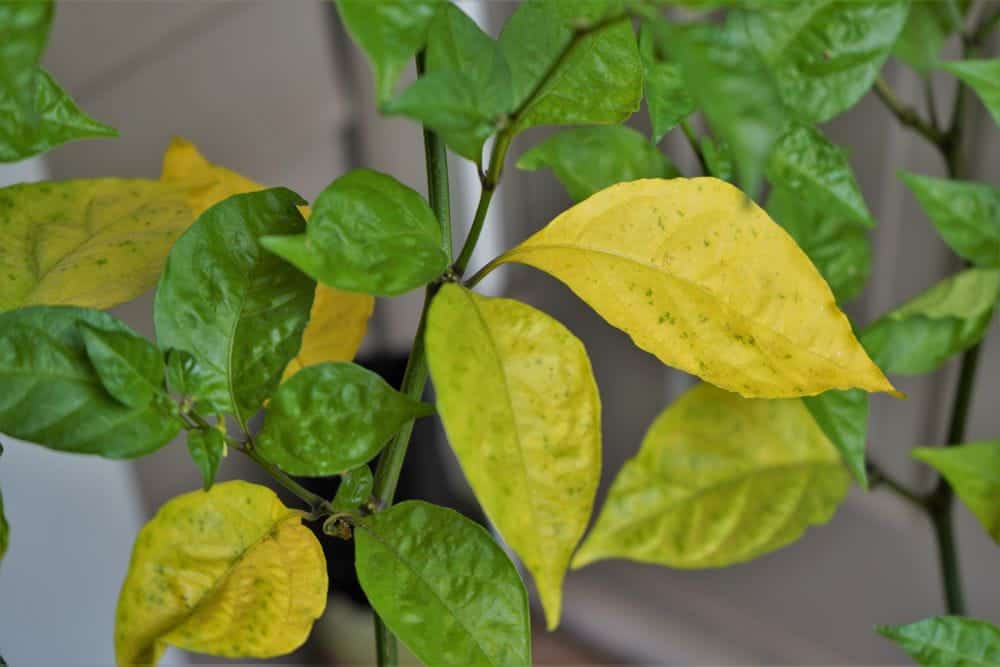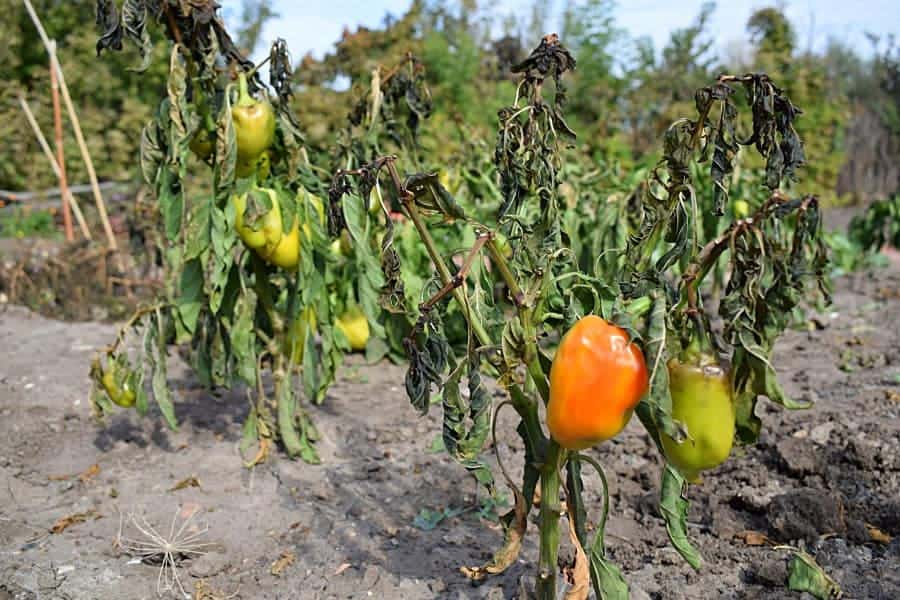Pepper plants are no longer strange to many families because they are grown throughout the garden and become an indispensable ingredient in many dishes such as salads, spicy dishes, etc.
Pepper plants are relatively easy to grow, easy to care for, and do not have to spend too much time on pruning and periodic fertilization. However, one of the mistakes many gardeners make is that pepper plants need a large amount of water each day.
In fact, pepper plants don’t need too much water each day and they only need it when the moisture in the soil starts to dry out.
So, if you are in the habit of watering pepper plants a lot and find that they are not growing properly, refer to 7 signs of overwatering pepper plants to find out the best way to fix it.
7 Signs Of Overwatering Pepper Plants
There are many signs that you can easily recognize when pepper plants are receiving too much water compared to their actual needs such as yellow leaves, not blooming, indicating many leaves, wilted plants, a layer of gray film, and rotting flowers, poorly drained soil, soft and shriveled leaves.
1. Pepper Plants Have Yellow Leaves
One of the obvious signs of your pepper plants being over-watered is the yellowing of leaves. This yellowing of leaves may appear for a few days after which the pepper plant may stop growing.

Most pepper plants prefer dry and hot climates to grow best. You should only water when you see that the soil moisture is dry, that’s the time when pepper plants need to be watered.
Besides, you also need to pay attention to growing pepper plants in pots or on the ground. Potted pepper drains faster than it does in soil, so when you grow your pepper plants in a pot you will probably have to water them more often than when growing them in the ground.
In addition, the poor drainage system also makes the roots of pepper plants waterlogged, the plant has difficulty in photosynthesis and lack of light will also cause the leaves to turn yellow simultaneously.
One of the phenomena that many gardeners confuse is the wilting and drooping of the leaves of the pepper plant. Most people will think that they are lacking water and continue to water more.
However, the phenomenon of leaves wilting and drooping is also a warning sign of over-watering pepper plants. Again, you should only water by checking the moisture in the soil because pepper plants are not the type of plant that like too much water every day.
2. The Pepper Plant Has Only Leaves, No Flowers
If you grow pepper plants and find that during the growing period they show many leaves without blooming, that is also a sign of overwatering.
Excessive watering during the growing period of pepper plants will dilute nutrients, fertilizers, and organic nutrients, making it difficult for pepper plants to absorb nutrients in the soil.
The roots of pepper plants will have to work hard to collect nutrients to nourish the plant so they will not have enough energy to produce flowers and fruits while the leaves have developed before and take advantage of this meager nourishment.
Therefore, during the time when pepper plants are growing strongly to flower and fruit, you need to provide enough water and fertilizer to stimulate them to flower and bear fruit. Use the right amount of water to dissolve all fertilizers and give pepper plants time to absorb those nutrients.
In addition, to prevent leaves from growing too much, you should prune old leaves or leaves at the top to avoid pepper plants growing too tall. This will help the plant concentrate energy and nutrients for flowering and fruiting.
In particular, you should water at the base instead of watering directly on the leaves. If the leaves of pepper plants are often wet, they are susceptible to fungal diseases.
You should water gradually so that the water infiltrates into the soil and creates certain moisture so that pepper plants can absorb water every day.
Read more: Expert Guide On How To Prune Pepper Plants For Maximum Yield – Simple, Easy Steps!
3. The Phenomenon Of Pepper Plants Withered And Half
Over-watering will also cause pepper plants to wilt because the roots have to work too hard and still do not receive enough nutrients for pepper plants to grow.

The phenomenon of pepper plants wilting due to excessive watering can often occur with young pepper plants. The reason is that the fungal bacteria in the soil that is too wet will thrive and attack young pepper plants during growth.
Therefore, according to gardeners, you should control the amount of water for each young pepper plant instead of watering the whole tray or container at the same time.
Young pepper plants should be planted in each tray or plot to ensure that they do not receive too much water per day. Therefore, you will choose the young pepper plants with the best growth and development.
At the same time, the trays or small plots will also limit the ability to accumulate too much water, causing the young pepper plants to become waterlogged and lead to wilting.
4. Gray Film On Leaves Or Tree Tops
If you notice a gray film on the leaves or tops of your pepper plants, you need to check the moisture in the soil as this is also an indication of the pepper plants being waterlogged.
This cling film is a phenomenon where moldy fungi attack the leaves of pepper plants and form a gray and disease-causing film. If you do not remove these diseased leaves, the mold will spread to other leaves and cause the pepper plant to quickly die.
To limit this situation, you should extend the watering times for pepper plants and only water under the tree, limiting water to the leaves to avoid mold having favorable conditions to develop.
In addition, you should clean the brown stains on the leaves with a washcloth or cotton swab. You should make sure that the tops of the pepper plants are not affected by this phenomenon because the fungus will destroy the tops and prevent the pepper plants from growing normally.
In addition, you should use low-chlorinated water, disinfectant, or let the water sit for about 10 minutes and remove the film on the water surface and start watering pepper plants to remove harmful substances, especially young pepper plants.
5. Soil Does Not Have Vent Holes, Secret And Sticky
Another common phenomenon that warns your pepper plant is over-watered is poor drainage, waterlogging, no more holes, and sticky soil.
The phenomenon of waterlogged and not porous soil will make it difficult for pepper plants to absorb oxygen in the soil. When the soil contains too much water, the roots will not have enough nutrients because the water dilutes the fertilizer and prevents the circulation of the pepper plants.
To solve this situation, you need to drain water in the soil, and till the soil to create porosity to provide more oxygen to the soil.
This will give the pepper plants time to exchange oxygen and absorb nutrients in the right moisture. If your soil is too wet, you can mix in sand, humus, or organic matter to dry the soil faster.
6. The Flower Of The Pepper Plant Is Rotten
Pepper plants’ flowers can rot if you over-water them while they’re flowering. The flowers of the pepper plant prefer dryness to attract insects, bees, and butterflies to pollinate, so if the outside environment is too humid, it will cause the flowers to rot.
In particular, the outside environment from leaves that are too wet will also be a suitable opportunity for the development of pests and fungi that destroy the development of flowers and fruits.
Another common cause of pepper plant flower rotting is the inability of the roots to absorb oxygen in the soil. In particular, this oxygen absorption is extremely important for the development of flowers to help them have enough energy and fruit.
You should water your pepper plants in the morning when there is sunlight so that the light can dry the leaves and flowers before dark. Watering in the evening creates favorable conditions for mold and other diseases to develop due to wet leaves and flowers.
7. The Leaves Of The Pepper Plant Are Prone To Shrinkage
The phenomenon of leaves of pepper plants shrinking and being soft is also caused by excessive watering. Leaves have to absorb too much water from the roots and stems that send them up causing them to become soft and curl.
These leaves cannot photosynthesize nor breathe oxygen, causing them to wilt, soften, and fall off.
Read more: Tiny Black Spots On Pepper Leaves And How To Get Rid Of Them!
Last Words
Over-watering pepper plants are extremely common for many gardeners. The signs of over-watering and under-watering can also be the same, so it’s a good idea to determine soil moisture before watering your plants.
Some of the basic signs of over-watering pepper plants are yellowing leaves, many leaves without flowers, wilting plants, the appearance of a color film, flowers are rotting, the soil is not draining, and leaves are soft, and shriveled.
To know more about the care process and the notes while growing pepper plants, you can refer to useful articles here.